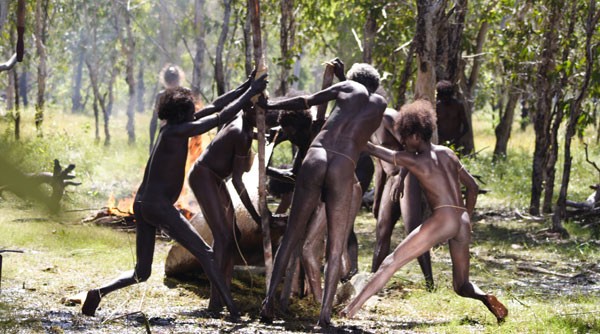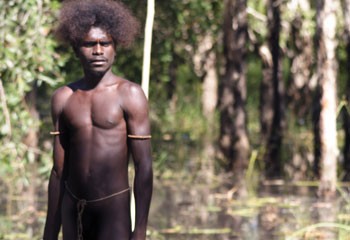 Stories within stories, a rare look at ancient Australian life and cultureTen Canoes
Stories within stories, a rare look at ancient Australian life and cultureTen Canoes is densely anthropological, a plunge into the original world of the Australian aborigines; it's also lightly entertaining, with its offhand voiceover and fart and prick jokes. On a deeper level it's about cultural continuity as moral continuity, and it's about death and coming of age and the fatality of choice in a world governed by the old laws. The native people speak their language, but David Gulpilil’s narration is in English. (Gulpilil was the star of Nicolas Roeg’s classic
Walkabout (1971), and his son is one of the principal actors in this film.) Does this English voiceover break the spell? Yes, it shows today’s aborigines are part of the modern world. And this "obtrusive" narration is necessary because the movie is also about storytelling ("This is not your story," Gulpilil says, twice, "but it’s a good story, just the same") and about the way traditional tales link back to earlier generations in an endless chain that always connects past with present.
The film is a story of ancient ancestors and a wife who goes missing, a revenge that goes wrong for a husband named Ridjimiraril (Crusoe Kurddal), told by less ancient (but still ancient) ancestors. Dayindi is the young listener and the storyteller is Minygululu (Peter Minygululu), a chief, talking all the time while he leads ten warriors out on an expedition to get bark and make canoes they use to hunt goose eggs in a crocodile-infested swamp, camping and sleeping in the swamp trees at night to be safe. The story requires several days to be told, and part of its purpose is just to teach Dayindi patience. The story and the voiceover are both also full of humor. And that tells us what? That the gestures and sense of humor have not changed.
The art of the film (apart from the beautiful cinematography and the compelling mise-en-scene) is in the way it juggles perceptions while also sliding them together—Dayindi, who the chief is telling the story to, and Yeeralparil, the ancient Ridjimiraril’s younger brother, are both played by narrator David Gulpilil’s son Jamie, and both characters covet their older brother’s pretty youngest wife—and the more recent ancestors' frame-story is in black and white while the most ancient one’s in color. In a sense these are two parallel tales, and the point of the first tale for Dayindi is to tell him that he will get a wife, if he'll just be patient, as Yeeralparil had to be.
The chief events—the disappearance, revenge, mishap, and payback—are in a color that, till the last reel, is somewhat less rich and deep than the black and white.
Ten Canoes captures the rhythm of an ancient tale: its repetitions, overlaps (overtly signaled by the parallel characters, but also by the shared humor and shared values) its lessons and delays. The constant forward motion—as we watch to see what will happen after Ridgjmariril’s wife disappears—is interrupted, as is the way of such tales, to get a perspective on things and heighten the suspense. Has she been stolen, or lost, or run away? Humorously, but also in the way of the storyteller whose bag of tricks includes alternate versions, we see the different possible outcomes appear one by one. And yet despite the ancient rhythms, there is something blatantly contemporary about the English voiceover, and the way it guides the viewer back and forth from the hunter-gatherers with the storytelling chief, and the more ancient people, whose story he tells.
This technique is skillfully used but has a certain distancing effect. Though
Ten Canoes has been compared to Zacharias Kunuk’s
Atanarjuat: The Fast Runner, this film doesn’t penetrate as deeply into a sense of otherness as Kunuk’s story, which takes you into the ice house and leaves you there, with a sense of lingering strangeness and danger. But
Ten Canoes is fascinating for the way it stimulates thoughts of cultural transmission, of what has changed and what has not. This is the first film made in an Australian indigenous language (Ganalbingu, one of the languages spoken in Arnhem Land, near the north central coast of Australia, east of Darwin; and a stranger speaks another language, Djinung). De Heer collaborated with the aboriginal co-director Peter Djirr, and this film, whose original inspiration was a set of old photographs, swept the Australian film awards. Maybe in future more films will be made in Australian indigenous languages and by aboriginal directors—and without even the mediation of an English voiceover to break the spell.






